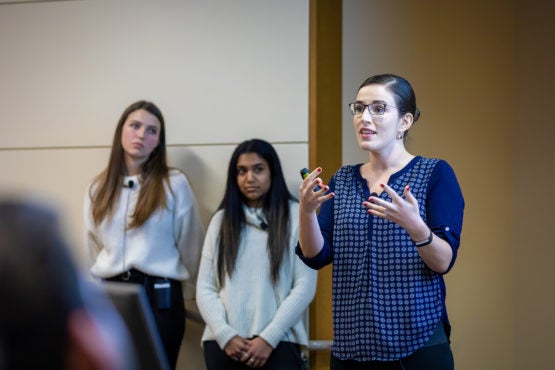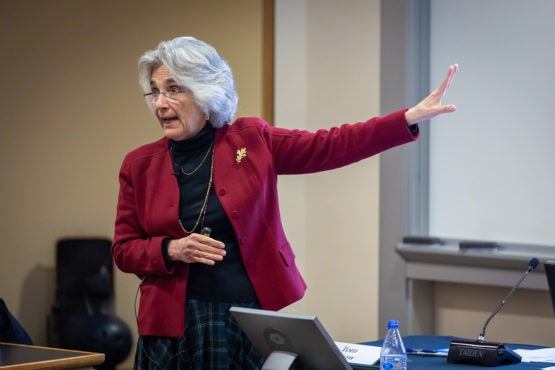Faculty Senate discusses sexual violence on campus
The Stanford Faculty Senate on Thursday discussed a wide range of topics related to sexual violence and sexual harassment on campus, with presentations by Provost Persis Drell and by three students representing the Associated Students of Stanford University. Drell also announced a new reporting structure for the Stanford University Press.
At the Faculty Senate meeting on Thursday, Provost Persis Drell and three students representing the Associated Students of Stanford University discussed a wide range of issues regarding sexual violence and sexual harassment on campus.
The meeting was a follow-up to a November meeting of the Faculty Senate that focused on the results of the Association of American Universities (AAU) 2019 Campus Climate Survey on Sexual Assault and Misconduct at Stanford. Since then, Stanford has released two reports of its own addressing sexual violence and sexual harassment on campus.

Stanford students Julia Paris, Krithika Iyer and Emma Tsurkov addressing the Faculty Senate on sexual violence and sexual harassment on campus. (Image credit: Farrin Abbott)
In addition, Drell announced a new reporting structure for the Stanford University Press.
Student proposal
In their presentation, students Emma Tsurkov, Julia Paris and Krithika Iyer said victims of sexual violence suffer academically, finding it hard to concentrate on assignments and exams, to attend classes regularly, to go to a campus job and to stay in school.
Iyer, an undergraduate student, said campus reports showed that 48 percent of undergraduate women and 57 percent of undergraduate men who experienced nonconsensual sexual contact since entering Stanford experienced it in residence halls or dorms, while 23 percent of undergraduate women and 7 percent of undergraduate men reported that nonconsensual sexual contact occurred in fraternity houses.
“We’re seeing that about one-third of men and women who are experiencing nonconsensual sexual contact are experiencing this from a former or current partner,” Iyer said. “A lot of them are experiencing it with friends, which shows that it’s not just going to a party and hooking up with someone you just met or an experience gone bad. It’s happening with people that you know, people that you trust.”
Iyer said the circumstances leading up to the nonconsensual contact differ depending on the perpetrator.
“We need policies that are robust enough to handle these different circumstances,” she said.
The students said faculty members could show they care about the issues by adding an announcement regarding Stanford policies and resources to their syllabi, such as the following paragraph proposed by the ASSU:
“Academic accommodations are available for students who have experienced sexual violence. If you would like to talk to a confidential resource, you can schedule a meeting with the Confidential Support Team or call their 24/7 hotline at: 650-725-9955. Counseling and Psychological Services also offers confidential counseling services. Non-confidential resources include the Title IX Office, for investigation and accommodations, and the SARA Office, for healing programs. Students can also speak directly with the teaching staff to arrange accommodations. Note that university employees – including professors and TAs – are required to report what they know about incidents of sexual or relationship violence, stalking and sexual harassment to the Title IX Office. Students can learn more at https://vaden.stanford.edu/sexual-assault.”
In addition, they said faculty members could clarify on their syllabi that academic accommodations are available to students who are recovering from the trauma of sexual violence.
They said Stanford could further support students by providing legal aid to students who have been sexually harassed by members of the faculty, and to clarify and improve the policies and procedures for reporting and investigating such allegations.
“There should be good and straightforward processes for handling sexual harassment complaints by students against faculty,” said Emma Tsurkov, a doctoral student in sociology in the School of Humanities and Sciences who earned a Master of Laws degree at Stanford Law School in 2015.
A call for cultural change
In her presentation, Provost Persis Drell discussed current and future programs designed to combat sexual violence and sexual harassment on campus, focusing on what Stanford is doing in the areas of prevention, support, and adjudication and sanctions.

Provost Persis Drell addressing the Faculty Senate on Thursday. (Image credit: Farrin Abbott)
She said the overall picture painted by the AAU survey and two Stanford reports – the Faculty Quality of Life Survey and the 2018-19 Title IX/Sexual Harassment Report – was “deeply disturbing.”
The reports showed that sexual violence is most prevalent in Stanford’s undergraduate population, and that sexual harassment is prevalent in all segments of the campus community. Drell highlighted some statistics from the reports:
- Among undergraduate women who have been at Stanford four years or more, 38.5 percent have experienced some form of nonconsensual sexual contact.
- 21 percent of Stanford students experienced some form of sexual harassment that seriously impacted their academic, professional or social life at Stanford.
- Only 19 percent of all victims of sexual violence or sexual harassment contacted university resources.
- 21 percent of female faculty members reported that they experienced offensive, objectionable or discriminatory behavior because of their gender in the 12 months prior to taking the Faculty Quality of Life Survey.
Drell, who said she was “enormously frustrated” by the slow pace of progress addressing sexual violence and sexual harassment on campus, said Stanford must continue to expand its prevention and education efforts, to augment its support services to make them more easily available and easier to navigate, and to evolve its adjudication and sanctions process to comply with legal requirements and embrace data-driven reforms.
“I am confident that we all care really deeply about this issue and that we don’t want sexual violence and sexual harassment on the Stanford campus,” she said. “But caring is not enough. The culture change that is going to be necessary to successfully address this challenge is not going to come quickly and it’s not going to come easily. It’s going to take a commitment on the part of every segment of our university. Your commitment is going to be needed if we really want to change. We can provide training, but you’ve got to use it.”
Prevention, support, adjudication and sanctions
Drell noted that Stanford has a variety of training programs designed to prevent sexual violence and sexual harassment on campus. Currently, all faculty and staff supervisors receive mandated biennial training, and all incoming undergraduate and graduate students receive online training. During New Student Orientation, undergraduates are also required to attend a live program, “Beyond Sex Ed: Consent & Sexuality at Stanford.”
This year, training programs will extend to all Stanford employees, including postdoctoral scholars, lecturers, adjunct and visiting faculty, and teaching assistants.
Drell said she would like to see more bystander/upstander training for faculty, because it is one of the most effective ways to address sexual harassment in the academic workplace. She also noted that many students have advocated for mandatory annual training for all undergraduate students – an idea she supports and hopes the ASSU leaders will endorse.
Turning to the issue of support, Drell said Stanford remains committed to providing emotional support to both victims of sexual violence and sexual harassment, as well as those who are accused of perpetrating such actions.
Among the resources currently available to the Stanford community are the Confidential Support Team, which provides therapeutic support to students; the Office of Sexual Assault and Relationship Abuse Education and Response (SARA), which provides support, education and advocacy; and the Faculty Staff Help Center.
Late last year, Stanford introduced the services of a YWCA Program Specialist who works in the Quillen apartment building in Escondido Village, focusing largely on relationship abuse and available to all members of the Stanford community. Drell said plans are underway to expand the YWCA support resources soon.
Regarding adjudication, Drell said there are several changes Stanford would like to make to the Student Title IX process, which is managed by the Title IX Office, based on the work of the university’s advisory committee on sexual assault policies and practice.
However, under an agreement with the Office for Civil Rights of the U.S. Department of Education, Stanford cannot modify any of its sexual violence or sexual harassment policies without prior approval. Stanford submitted proposed policy changes in 2018, but has not yet received a reply from the federal agency, she said.
Drell said she anticipates that Stanford will have to modify its practices and procedures to comply with new Title IX regulations that are expected to be issued soon by the U.S. Department of Education. She said Stanford is also seeking advice from external reviewers who have been asked to conduct a review of the university’s Title IX, SARA and Sexual Harassment Policy Office in March.
In addition, Stanford is considering recommendations from the ASSU and other student advocacy groups, Drell said.
When the senate opened the floor to discussion following the presentations, senators commented on a variety of issues raised by the provost and the students. Several faculty members said they approved of the idea of bystander/upstander training. One senator encouraged Stanford to create the most user-friendly website possible to help improve transparency of the university’s programs and policies.
In answer to a question, Drell said she would not support providing legal aid to students who file complaints against faculty members, noting that the structure of the investigation process is very different in nature from the Student Title IX Process, where Stanford does provide student participants with free legal aid. However, she said students could benefit from getting additional help in navigating the process.
Stanford University Press
Last year, two faculty committees – one convened by the provost and another convened by the senate – completed reports on pressing issues facing the Stanford University Press, including faculty engagement, governance, funding and its vision for the future.
“The essential point that came through in both reports – and I think it’s something we knew – was that we are not going to be able to truly move forward to ensure a robust future of the Stanford University Press without the engagement of the Stanford faculty,” Drell said.
Drell said she has accepted the first two recommendations of the Provostial Committee on the Future of the Stanford University Press: that the Press report to the Office of the Provost, rather than Stanford University Libraries, and also report to a budget officer.
Drell said both recommendations will go into effect immediately. Professor Richard Saller, former dean of the School of Humanities and Sciences, will provide oversight for the Press, and Tim Warner, vice provost for budget and auxiliaries management, will provide financial oversight, she said.
Drell said she has also accepted the recommendation to create a governing board – a concept endorsed by both committees – for the Press. She said she will begin working on a charter, but will defer questions about membership until the senate has decided on the form and composition of its oversight committee on the Press.
The minutes of the Nov. 21 meeting are available on the Faculty Senate website. The next senate meeting will be held Thursday, Feb. 6.
